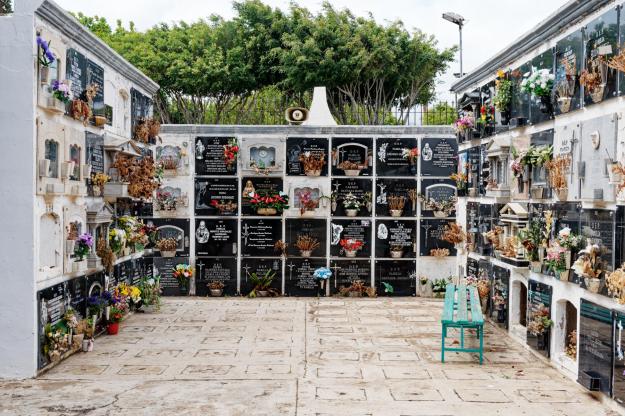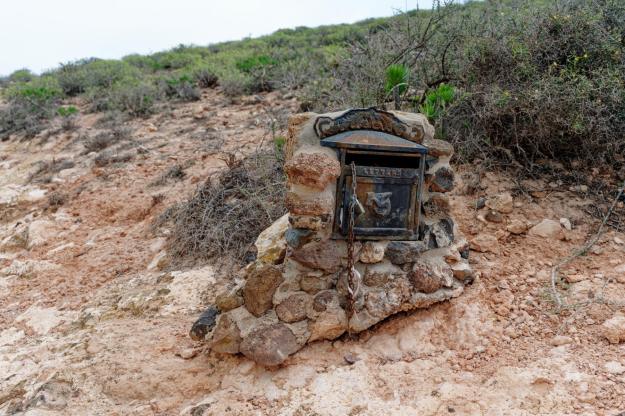Sunday March 6 2022 – The day dawned with a great deal more sun in the sky and a great deal less wind in the air, which meant that the plan that Jane had formulated for the day looked a good’un. The idea was to hie ourselves swiftly down to the south of the island, taking up where we left off yesterday, and head up towards the central peak, taking in viewpoints and other items of interest on the way. As usual, we had a lot to get through. As usual, we didn’t achieve it all. As usual, we had a lot of fun trying.
The journey down to the south of the island takes about 30 minutes, during which I managed to get almost entirely to grips with the cruise control on the Peugeot without, I’m glad to say, causing any accidents, at least none that I noticed. Having got back to Maspalomas, we headed northish to something that Jane had spotted on Google Maps, which was an aqueduct built out from the rocks, which looked like it might be quite interesting. So we drove up to the point where the road became a track and then walked up the track. It was so beautifully not windy that I could actually wear a hat as protection from the sun, which was obligingly shining fit to split any paving stones it happened upon. After a short walk, we saw the aqueduct, which was indeed built out from the rock on to arches.

That was the thing we’d come to see, but whilst I was scrambling across the terrain to capture the photo from this particular angle, only getting lightly injured in the process, Jane had noticed that a little further up the track the aqueduct went across some further arches. So we walked up and examined them, initially from a distance

and then decided that it might be possible to scramble up and take a look at the water course itself (Jane had seen a photo of water flowing along the aqueduct). So, scramble we did, and we managed to get up to the arches, at which point we saw

that the water now flowed along a pipe rather than in an open channel. While it makes a great deal of sense in terms of saving on evaporation and being more efficient, etc etc, it was a little disappointing to find. However, getting up there enabled us to get a better view of the very enormous rock processing facility across the way,

and heading back down gave us some more photos of and through the arches.


On the way back down to the car, we noticed that there were some caves by the track.


We’re not sure of the provenance of them, but they look like they might have once housed people.
Our next stop was at a viewpoint a bit further up the into the hills, with the grand title of Mirador Astronómico de la Degollada de las Yeguas. It being a Sunday, and the mirador being up a twisty mountain road, it was very popular among the local biker population.

The use of “astronomic” in naming the viewpoint comes from its popularity for watching the stars – not like The Ivy or the Wolseley, I mean the night sky. It apparently gets dark at night without getting cold, which makes it a good place to gaze at the heavens.
But even during the day, you get a pretty staggering view. It’s a huge panorama.



Our next stop was a necropolis. Sorry about the focus on death here, but it can be interesting. Just up the valley, near the village of Fataga, is the necropolis of Arteara. This is not a vast and impressive spread like the one we saw yesterday or in Menorca, but we thought it worth investigating anyway.
There were signposts to the site, but it turned out that the necropolis itself is quite subtle and not at all easy to spot until you know what you’re looking for. There is a track of sorts, which leads you to a viewpoint

from which, an information board tells you, you can see many many tumuli (burial chambers) among the rocks.

No, we couldn’t spot them, either. However, once you know what you’re looking for, you can begin to distinguish them.

There’s one pretty near the centre of the photo above – look for a hole in a pile of rocks. Here’s what it looks like close to.

Bodies were laid out on cists (platform slabs) and then covered with more rocks. The local reddish stone is easy to break up to be able to do this, we are told. After a bit, you can see tumuli all over the place.


and you can begin to understand how it is that there are over 200 tumuli in total across the site. Jane had seen some pictures of a neolithic cave network, but we couldn’t find that. What we did find instead were some traditional beehives, constructed from the trunks of palm trees

and some very fine views over the area.

The palm trees are further evidence of the neolithic community that once lived here.
The nearby village of Fataga had a couple of restaurants and so we thought we’d try our luck at getting some lunch. Remarkably, we were able (a) to park the car and (b) to get a table in a very busy restaurant called El Albaricoque. They managed to fit us in and served us a decent lunch with, mirabile dictu, plenty of vegetables, a constituent that has largely been missing from most of the meals we’ve had here; and we’re of an age where getting one’s veg is almost as important as getting one’s Earl Grey tea.

The restaurant was next door to an art gallery which looked like it would have been fun to visit, had it not been Sunday and therefore closed.


Time was beginning to motor on by this stage and so we decided we’d better do the same, therefore ditching a couple of the optional sites to visit in favour of basically hightailing it back to the hotel across the middle of the island. Since the middle of the island is a fucking great very substantial mountain, we had quite an intricate journey along roads that Jane is fond of calling “intestinal” – narrow, twisty and occasionally making one shit oneself. However, the route went through an attractive town called Santa Lucia, and I couldn’t resist stopping to take a few quick photos.



And as we wound (a very apposite description of the roads) our way towards home in the setting sun the light gave us some absolutely marvellous views along the way.






We arrived back at the hotel well after sunset, and, as ever not having quite hit all the targets we had originally planned. But it’s been a good day and I managed those twisty roads without damaging the car in any obvious fashion, which is good.
Jane’s plan for the morrow involves going to the north of the island. Hitherto, the weather in the north has not been brilliant, but the forecast for tomorrow is good, so we shall sleep well and optimistically tonight with the prospect of another good day tomorrow. So please come back to these pages soon and take a look at how we get on.











































